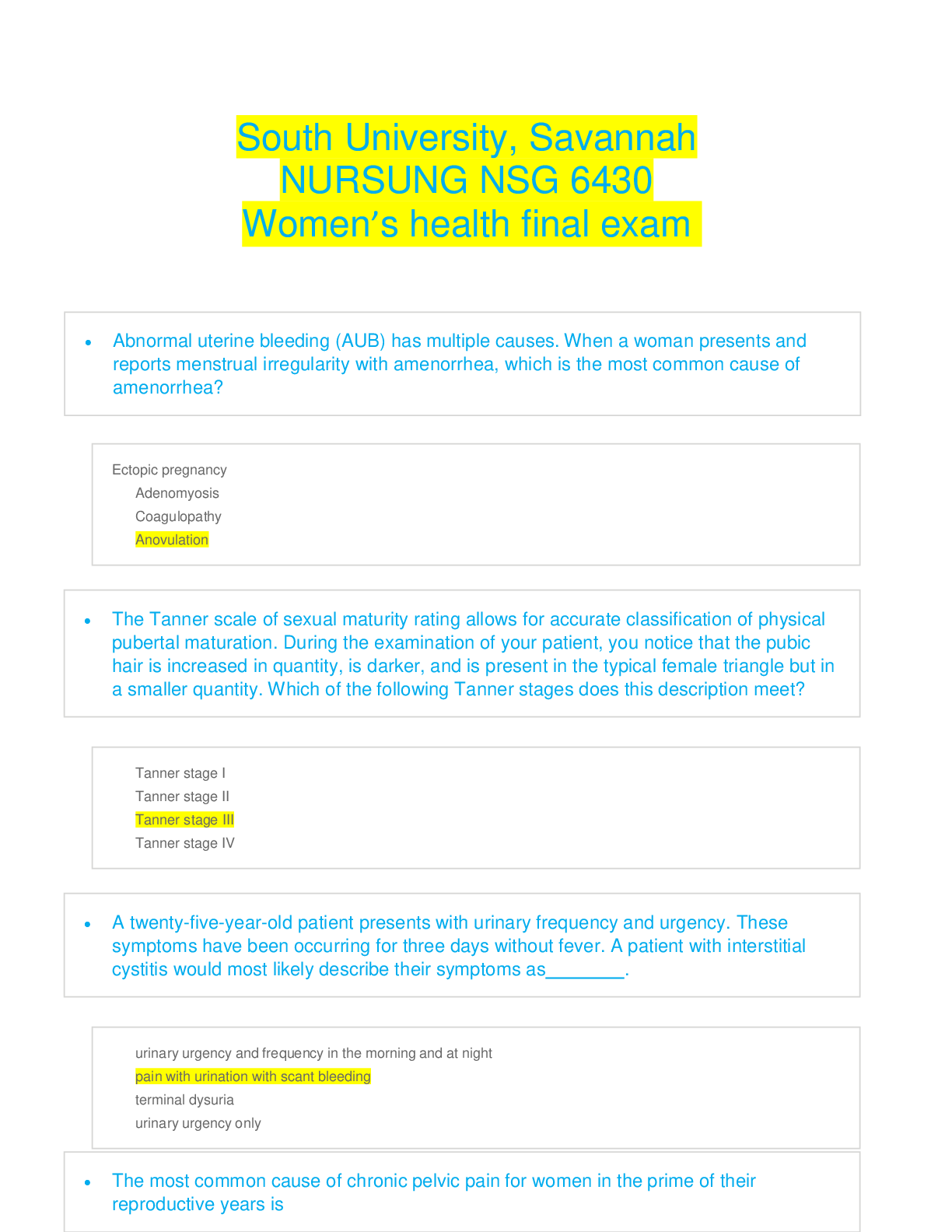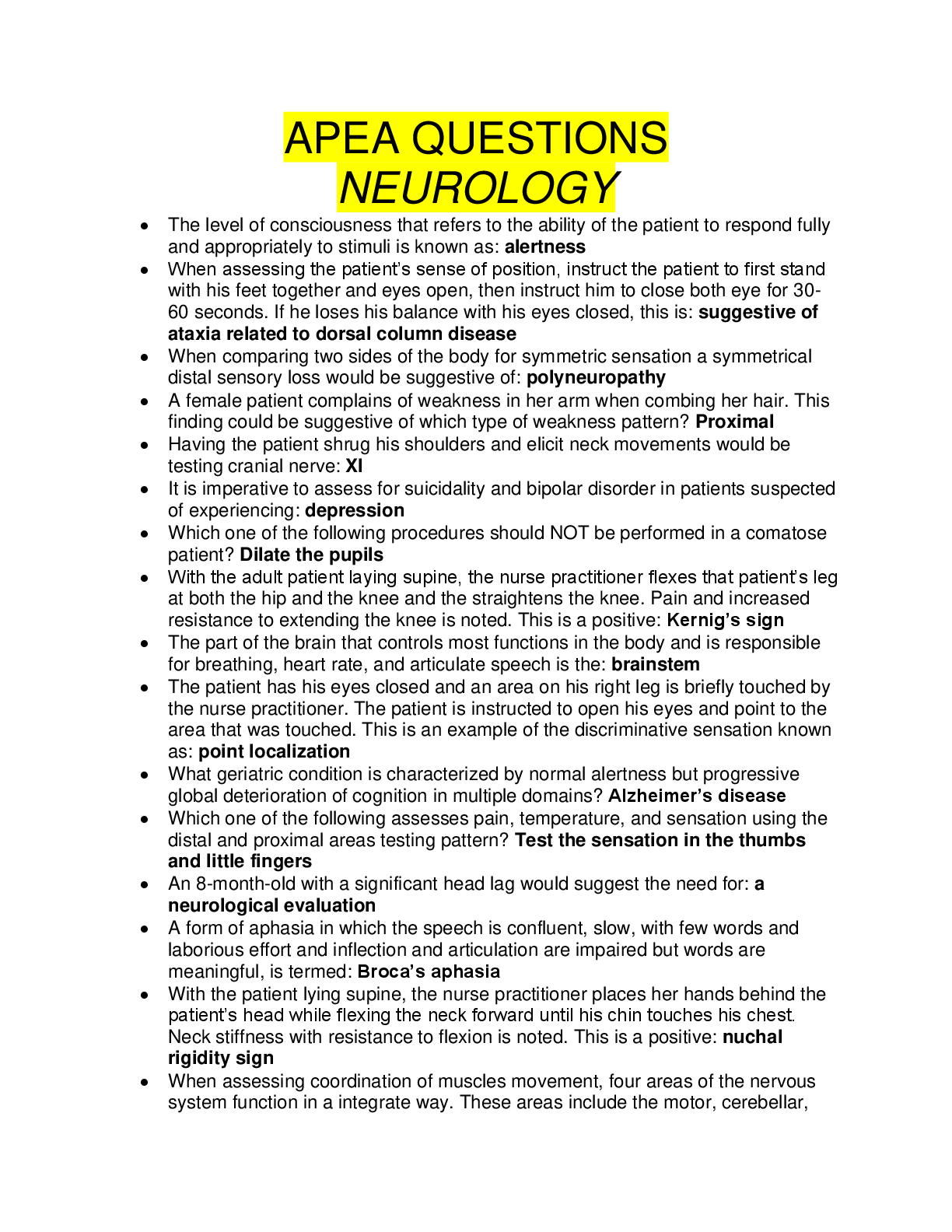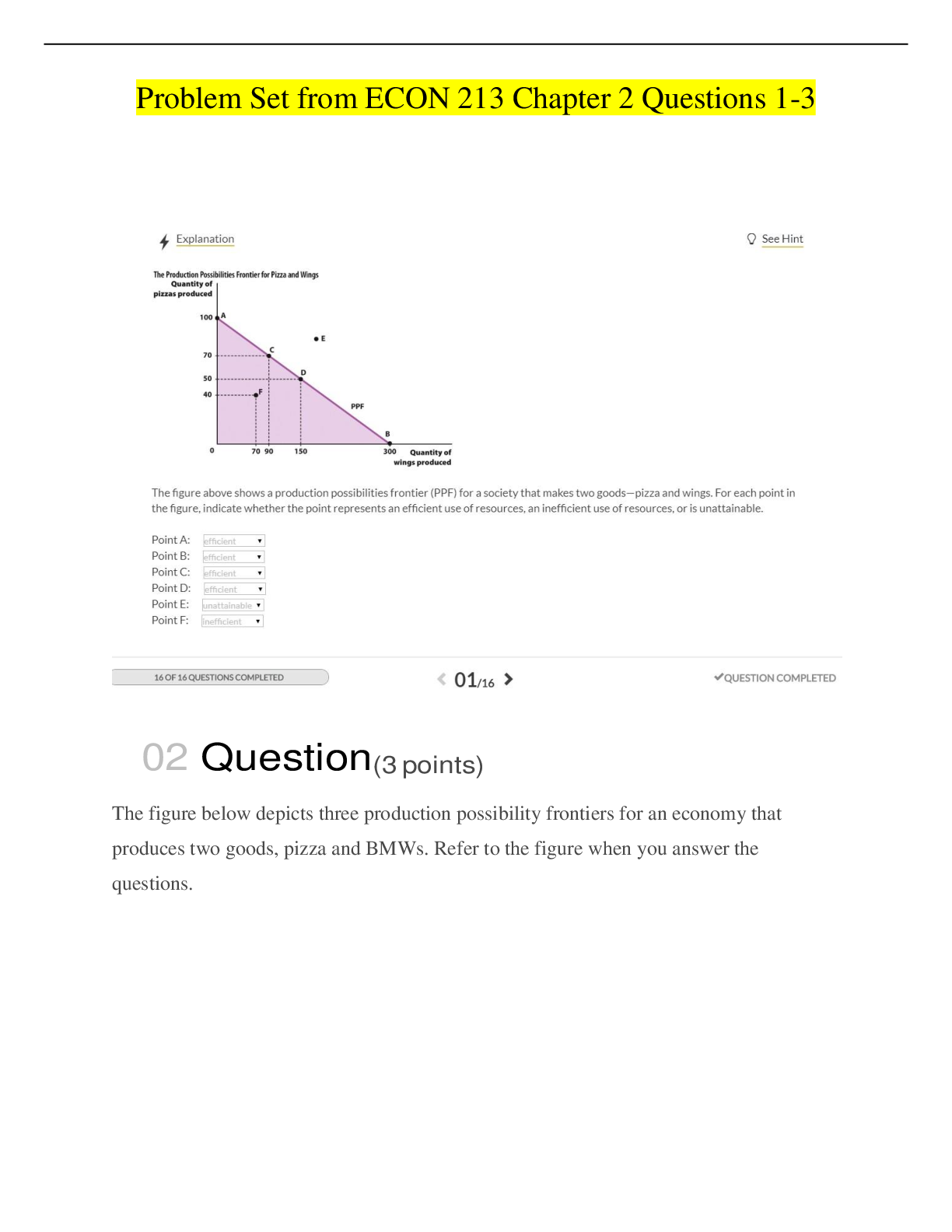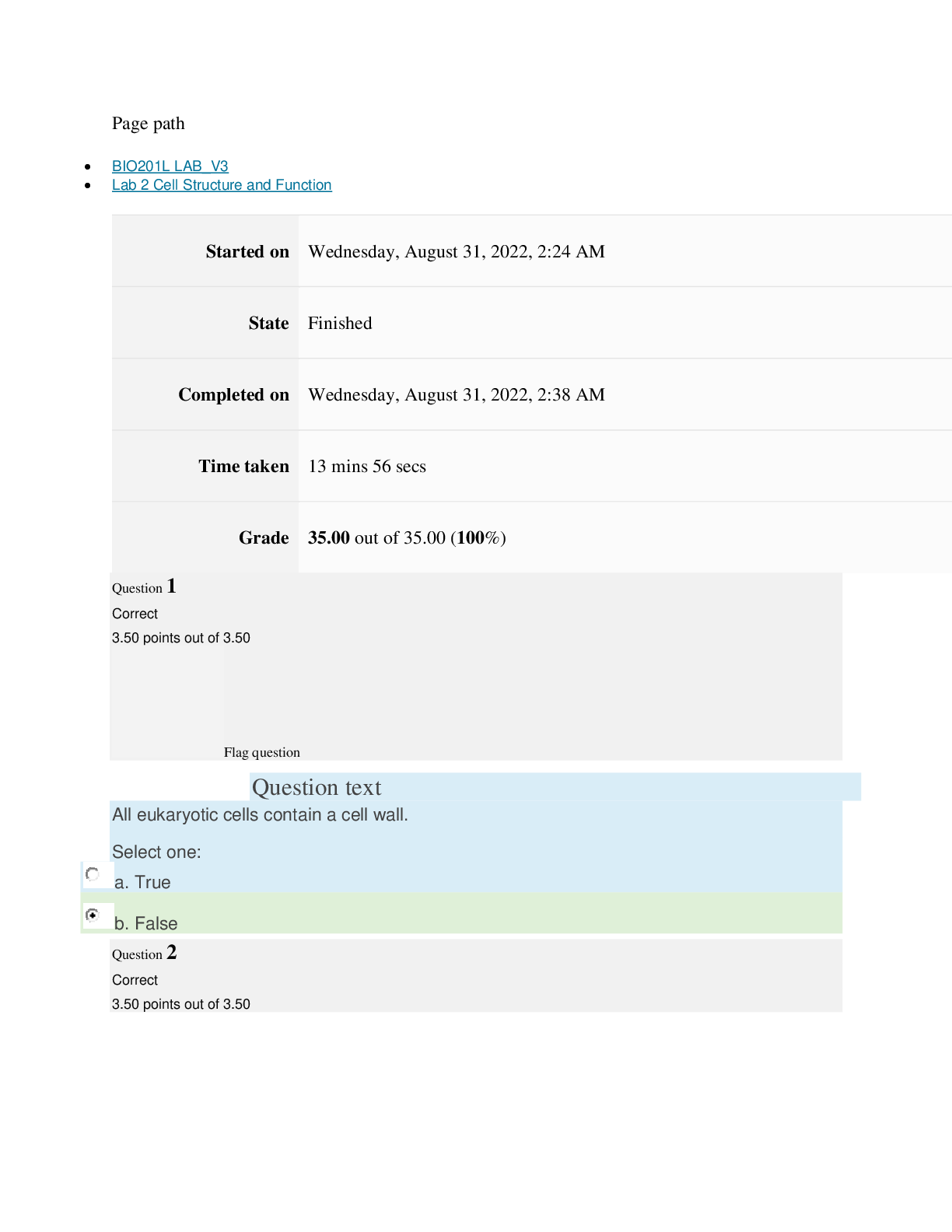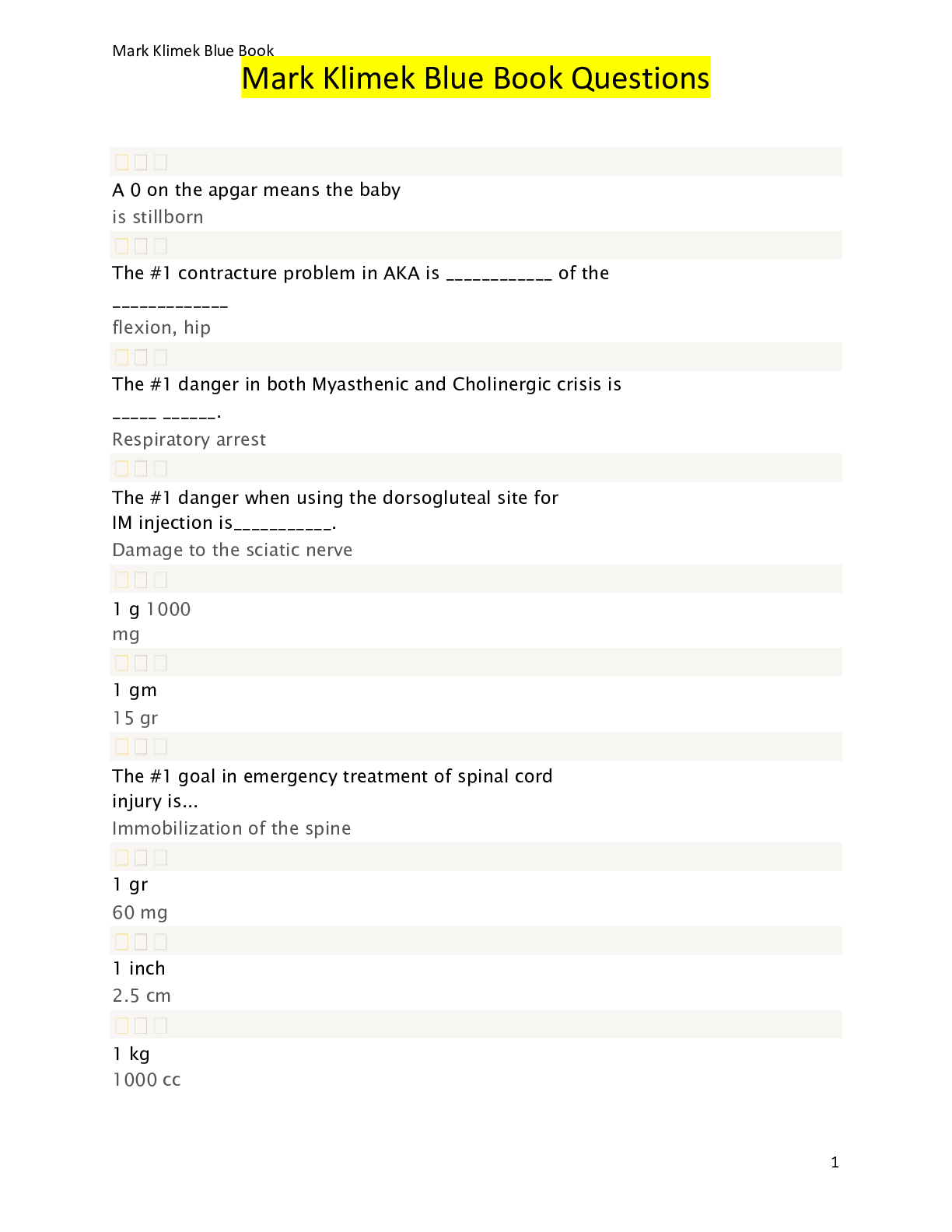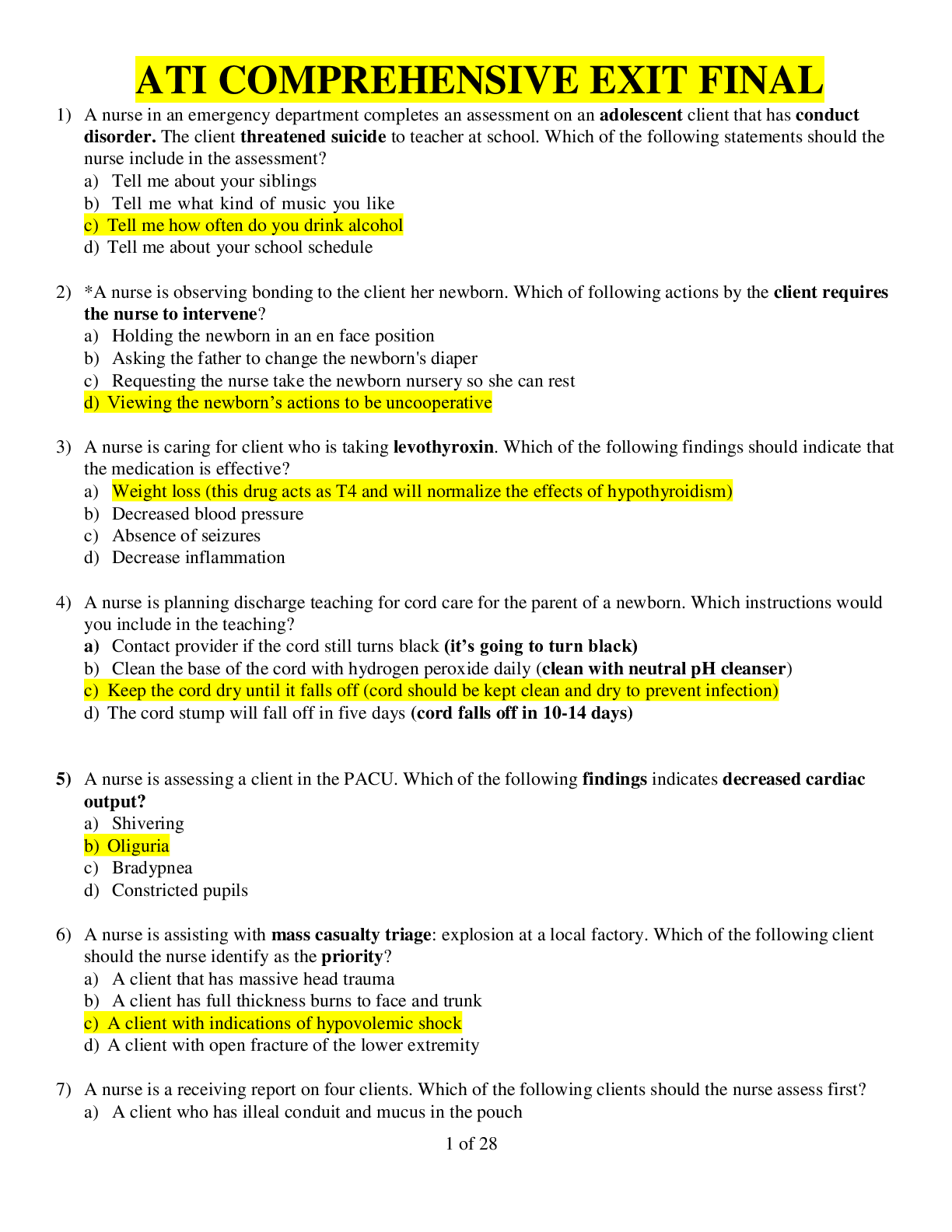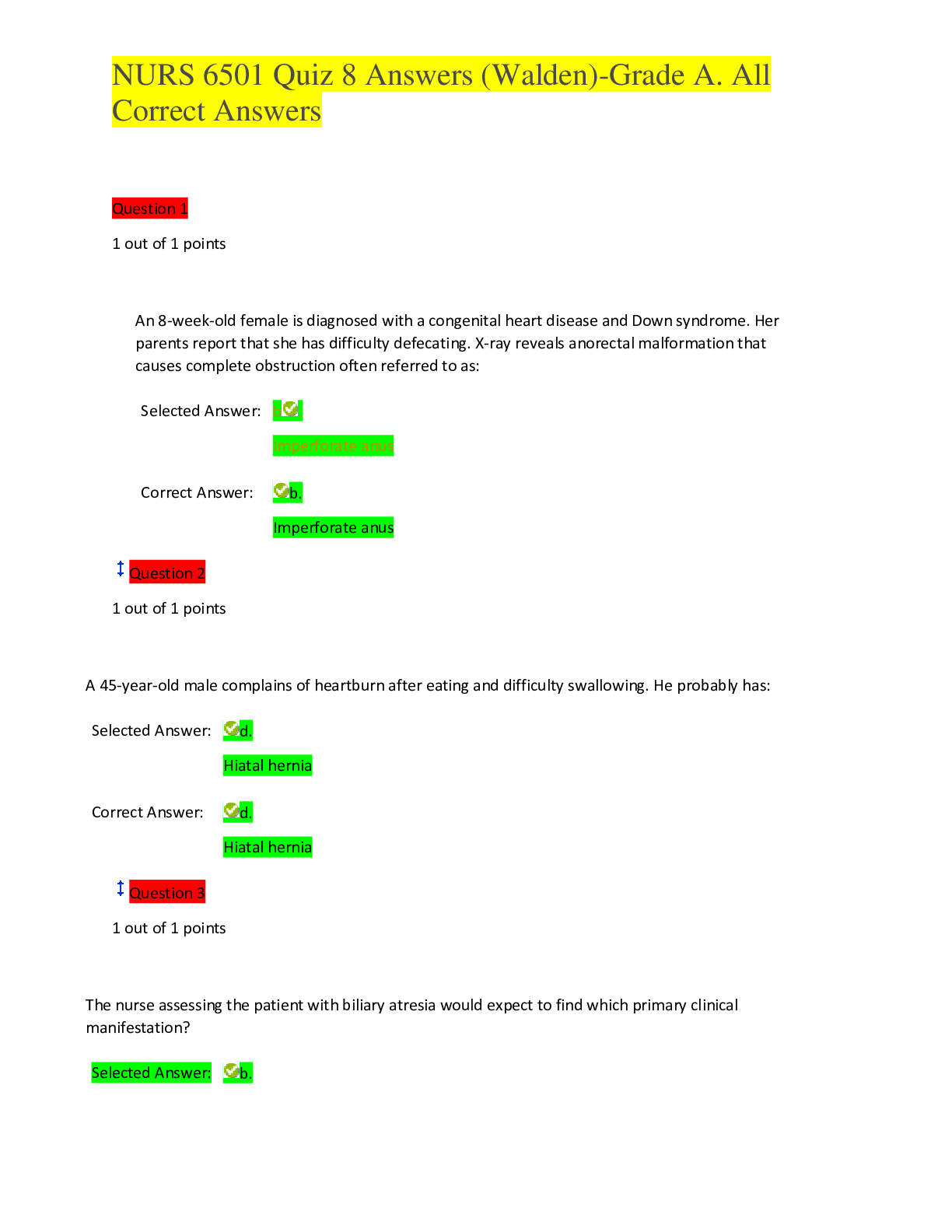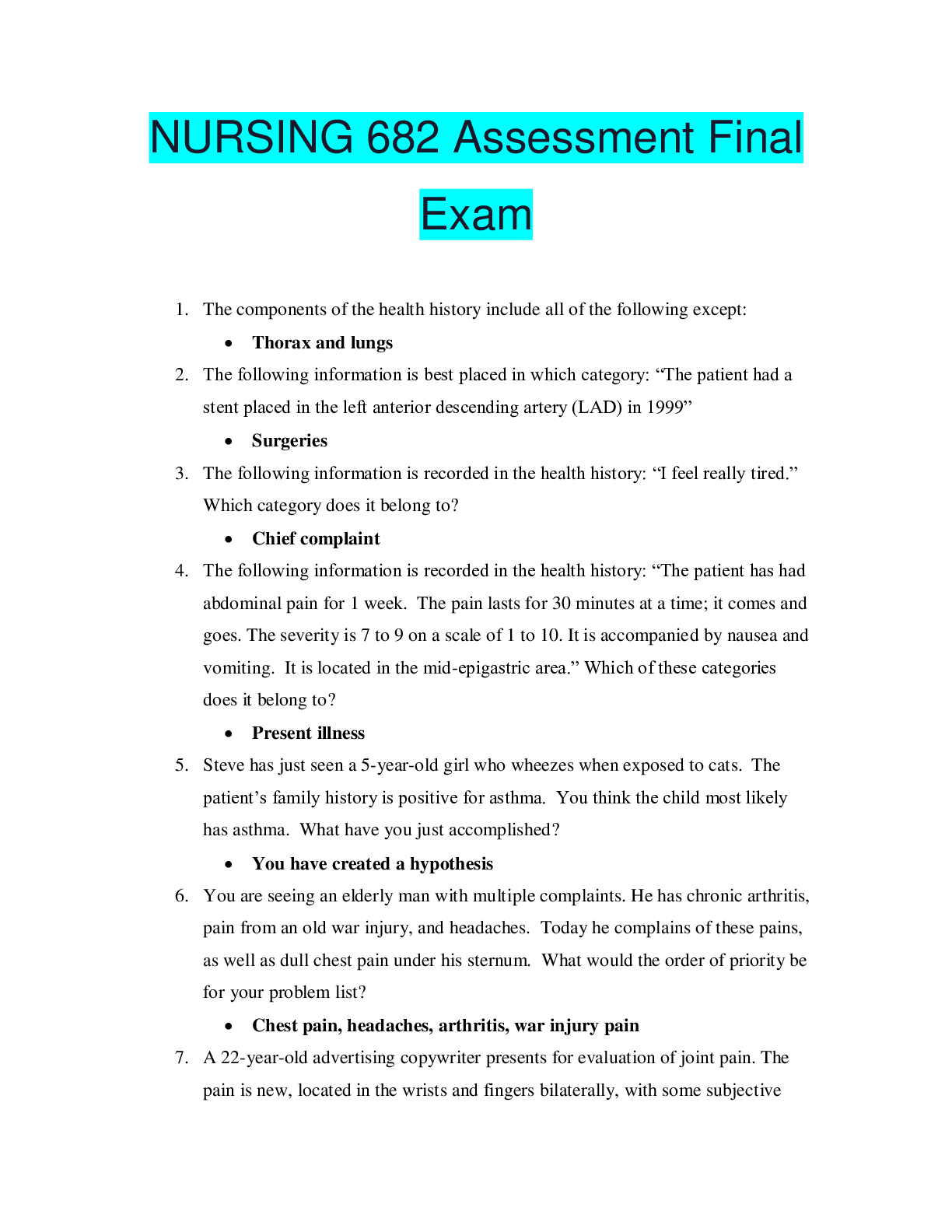*NURSING > QUESTIONS & ANSWERS > Walden University > Nursing > Walden University - NURS 6501 QUIZ 3/ NURS6501 Quiz3 (All)
Walden University > Nursing > Walden University - NURS 6501 QUIZ 3/ NURS6501 Quiz3
Document Content and Description Below
NURS6501Quiz3 QUESTION 1 Parents of a 3-month-old infant bring him to the emergency room (ER) after he has had a seizure. He has muscle rigidity, and the parents report they are of Jewish ancestry.... For what genetic disease should this infant be screened? a . Juvenile myoclonic epilepsy b . Congenital encephalopathy c . Tay-Sachs disease X d . PKU QUESTION 2 A 40-year-old male complains of uncontrolled excessive movement and progressive dysfunction of intellectual and thought processes. He is experiencing movement problems that begin in the face and arms that eventually affect the entire body. The most likely diagnosis is: a. Tardive dyskinesia b. Huntington disease X c. Hypokinesia d. Alzheimer disease QUESTION 3 A 72-year-old male demonstrates left-sided weakness of upper and lower extremities. The symptoms lasted 24 hours and resolve with no evidence of infarction. The patient most likely experienced a(n): a. MI evaluation b. Arteriovenous malformation c. Transient ischemic attack X d. Cerebral hemorrhage QUESTION 4 A 60-year-old female with a recent history of head trauma and a long-term history of hypertension presents to the ER for changes in mental status. MRI reveals that she had a hemorrhagic stroke. What does the nurse suspect caused this type of stroke? a. Rheumatic heart disease b. Thrombi c. Aneurysm X d. Hypotension QUESTION 5 A 15-year-old male is brought to the ER for treatment of injuries received in a motor vehicle accident. An MRI reveals spinal cord injury, and his body temperature fluctuates markedly. The most accurate explanation of this phenomenon is that: a. He developed pneumonia. b. His sympathetic nervous system has been damaged and thermal control disturbed. X c. He has a brain injury. Queston 1 A nurse should document on the chart that chronic pain is occurring when the patient reports the pain has lasted longer than: a. 1 month b. 3 to 6 months X c. 1 year d. 2 to 3 years Queston 2. A 16-year-old male took a recreational drug that altered his level of arousal. Physical exam revealed a negative Babinski sign, equal and reactive pupils, and roving eye movements. Which of the following diagnosis will the nurse most likely see on the chart? a. Psychogenic arousal alteration b. Metabolically induced coma X c. Structurally induced coma d. Structural arousal alteration Queston 3 A 30-year-old female had a seizure that started with her Fingers and progressively spread up her arm and then extended to her leg, with no loss of consciousness. How should the nurse chart this? a. Myoclonic seizure b. tonic-clonic seizure c. focal motor seizure X d. Atonic seizure Question 4 A teenage boy sustains a severe closed head injury following an all-terrain vehicle (ATV) accident. He is in a state of deep sleep that requires vigorous stimulation to elicit eye opening. How should the nurse document this in the chart? a. Confusion b. Coma c. Obtundation d. Stupor X Question 5 A 15-year-old male was struck by a motor vehicle and suffered a traumatic brain injury. Paramedics found him unconscious at the scene of the accident. During the ambulance ride, he regained consciousness and was able to maintain a conversation with the medical staff. Upon arrival to hospital, he was alert and oriented. Physical exam reveals confusion and impaired responsiveness. What is the probable nature of his brain injury based on this history? a. Mild concussion b. Subdural hematoma c. Extradural (epidural) hematoma X d. Mild diffuse axonal injury 1. A 60-year-old female with a recent history of head trauma and a long-term history of hypertension presents to the ER for changes in mental status. MRI reveals that she had a hemorrhagic stroke. What does the nurse suspect caused this type of stroke? a. Rheumatic heart disease b. Thrombi c. Aneurysm d. Hypotension 1 points QUESTION 2 1. A 50-year-old male suffers a severe head injury when his motorcycle hits a tree. His breathing becomes deep and rapid but with normal pattern. What term should the nurse use for this condition? a. Gasping b. Ataxic breathing c. Apneusis d. Central neurogenic hyperventilation 1 points QUESTION 3 1. A 20-year-old male was at the supermarket when he fell to the ground. Bystanders reported that he lost consciousness and his body tensed up then relaxed, then tensed and relaxed several times. He most likely was experiencing a(n): a. Partial seizure b. Absence seizure c. Myoclonic seizure d. Tonic-clonic seizure 1 points QUESTION 4 1. A 65-year-old male recently suffered a cerebral vascular accident. He is now unable to recognize and identify objects by touch because of injury to the sensory cortex. How should the nurse document this finding? a. Hypomimesis b. Agnosia c. Dysphasia d. Echolalia 1 points QUESTION 5 1. Which finding indicates the patient is having complications from heat stroke? a. Mild elevation of core body temperatures b. Cerebral edema and degeneration of the CNS c. Spasmodic cramping in the abdomen and extremities d. Alterations in calcium uptake 1 points QUESTION 6 1. A 15-year-old male is brought to the ER for treatment of injuries received in a motor vehicle accident. An MRI reveals spinal cord injury, and his body temperature fluctuates markedly. The most accurate explanation of this phenomenon is that: a. He developed pneumonia. b. His sympathetic nervous system has been damaged and thermal control disturbed. c. He has a brain injury. d. He has septicemia from an unknown source. 1 points QUESTION 7 1. A 69-year-old male with a history of alcohol abuse presents to the emergency room (ER) after a month-long episode of headaches and confusion. Based on his alcoholism, a likely cause of his neurologic symptoms is: a. Concussion b. Chronic subdural hematoma c. Epidural hematoma d. Subacute subdural hematoma 1 points QUESTION 8 1. When a patient has a peculiar sensation that immediately precedes a seizure, what term should the nurse use to describe this sensation? a. Prodroma b. Agnosia c. Spasm d. Aura 1 points QUESTION 9 1. A 40-year-old male complains of uncontrolled excessive movement and progressive dysfunction of intellectual and thought processes. He is experiencing movement problems that begin in the face and arms that eventually affect the entire body. The most likely diagnosis is: a. Tardive dyskinesia b. Huntington disease c. Hypokinesia d. Alzheimer disease 1 points QUESTION 10 1. A 16-year-old male took a recreational drug that altered his level of arousal. Physical exam revealed a negative Babinski sign, equal and reactive pupils, and roving eye movements. Which of the following diagnosis will the nurse most likely see on the chart? a. Psychogenic arousal alteration b. Metabolically induced coma c. Structurally induced coma d. Structural arousal alteration 1 points QUESTION 11 1. A 20-year-old male was brought to the emergency room (ER) for severe burns. He requested something for the excruciating pain he was experiencing. Blocking which of the following neurotransmitters would reduce his pain? a. Enkephalin b. Dopamine c. Acetylcholine d. Substance P 1 points QUESTION 12 1. A 20-year-old male suffers a severe closed head injury in a motor vehicle accident. He remains in a vegetative state (VS) 1 month after the accident. Which of the following structures is most likely keeping the patient alive? a. Cerebral cortex b. Brainstem c. Spinal cord d. Cerebellum 1 points QUESTION 13 1. A 30-year-old female had a seizure that started with her fingers and progressively spread up her arm and then extended to her leg, with no loss of consciousness. How should the nurse chart this? a. Myoclonic seizure b. Tonic-clonic seizure c. Focal motor seizure d. Atonic seizure 1 points QUESTION 14 1. A patient has memory loss of events that occurred before a head injury. What cognitive disorder does the nurse suspect the patient is experiencing? a. Selective memory deficit b. Anterograde amnesia c. Retrograde amnesia d. Executive memory deficit 1 points QUESTION 15 1. A patient with an addiction to alcohol checked into a rehabilitation center. He experiences delirium, inability to concentrate, and is easily distracted. From which of the following is he most likely suffering? a. Acute confusional state b. Echolalia c. Dementia d. Dysphagia 1 points QUESTION 16 1. The nursing student would correctly identify the most common symptom of brain abscess as: a. Nuchal rigidity b. Vomiting c. Drowsiness d. Headache 1 points QUESTION 17 1. A 23-year-old female begins having problems with tiredness, weakness, and visual changes. Her diagnosis is multiple sclerosis (MS). What is occurring in the patient’s body? a. Depletion of dopamine in the central nervous system (CNS) b. Demyelination of nerve fibers in the CNS c. The development of neurofibril webs in the CNS d. Reduced amounts of acetylcholine at the neuromuscular junction 1 points QUESTION 18 1. A 15-month-old child from Pennsylvania was brought to the ER for fever, seizure activity, cranial palsies, and paralysis. Which of the following diagnosis will be documented in the chart? a. Eastern equine encephalitis b. Venezuelan encephalitis c. St. Louis encephalitis d. West Nile encephalitis 1 points QUESTION 19 1. When a patient has a fever, which of the following thermoregulatory mechanisms is activated? a. The body’s thermostat is adjusted to a lower temperature. b. Temperature is raised above the set point. c. Bacteria directly stimulate peripheral thermogenesis. d. The body’s thermostat is reset to a higher level. 1 points QUESTION 20 1. Parents of a 3-month-old infant bring him to the emergency room (ER) after he has had a seizure. He has muscle rigidity, and the parents report they are of Jewish ancestry. For what genetic disease should this infant be screened? a. Juvenile myoclonic epilepsy b. Congenital encephalopathy c. Tay-Sachs disease d. PKU 1 points QUESTION 21 1. An initial assessment finding associated with acute spinal cord injury is _____ the injury. a. Pain below the level of b. Loss of autonomic reflexes above c. Loss of voluntary control below d. Hyperactive spinal reflexes below 1 points QUESTION 22 1. A nurse should document on the chart that chronic pain is occurring when the patient reports the pain has lasted longer than: a. 1 month b. 3 to 6 months c. 1 year d. 2 to 3 years 1 points QUESTION 23 1. A teenage boy sustains a severe closed head injury following an all-terrain vehicle (ATV) accident. He is in a state of deep sleep that requires vigorous stimulation to elicit eye opening. How should the nurse document this in the chart? a. Confusion b. Coma c. Obtundation d. Stupor 1 points QUESTION 24 1. Which system modulates a patient’s perception of pain? a. Reticular-discriminative system b. Affective-motivational system c. Cognitive-evaluative system d. Reticular-activating system 1 points QUESTION 25 1. A child presents to his primary care provider with disorientation, delirium, aggressiveness, and stupor. His parents report that he was recently ill with an upper respiratory infection, which they treated with aspirin. Which of the following is the most likely diagnosis? a. Epilepsy b. Reye syndrome c. Tay-Sachs d. PKU Question 12 A 75-year-old female suffers a stroke and now has difficulty writing and production of language. This condition is most likely caused by occlusion of the: Question 12 An initial assessment finding associated with acute spinal cord injury is_____ the injury. Question 9 A nurse thinks a patient may be experiencing dementia. Which assessment finding will most help support this diagnosis? • Question 1 1 out of 1 points A child presents to his primary care provider with disorientation, delirium, aggressiveness, and stupor. His parents report that he was recently ill with an upper respiratory infection, which they treated with aspirin. Which of the following is the most likely diagnosis? • Question 2 1 out of 1 points A 50-year-old male suffers a severe head injury when his motorcycle hits a tree. His breathing becomes deep and rapid but with normal pattern. What term should the nurse use for this condition? • Question 3 1 out of 1 points A 30-year-old female had a seizure that started with her fingers and progressively spread up her arm and then extended to her leg, with no loss of consciousness. How should the nurse chart this? • Question 4 1 out of 1 points A 20-year-old male was brought to the emergency room (ER) for severe burns. He requested something for the excruciating pain he was experiencing. Blocking which of the following neurotransmitters would reduce his pain? • Question 5 1 out of 1 points A 16-year-old male took a recreational drug that altered his level of arousal. Physical exam revealed a negative Babinski sign, equal and reactive pupils, and roving eye movements. Which of the following diagnosis will the nurse most likely see on the chart? • Question 6 1 out of 1 points A 69-year-old male with a history of alcohol abuse presents to the emergency room (ER) after a month-long episode of headaches and confusion. Based on his alcoholism, a likely cause of his neurologic symptoms is: • Question 7 1 out of 1 points The nursing student would correctly identify the most common symptom of brain abscess as: • Question 8 1 out of 1 points A 23-year-old female begins having problems with tiredness, weakness, and visual changes. Her diagnosis is multiple sclerosis (MS). What is occurring in the patient’s body? • Question 9 1 out of 1 points A patient with an addiction to alcohol checked into a rehabilitation center. He experiences delirium, inability to concentrate, and is easily distracted. From which of the following is he most likely suffering? • Question 10 1 out of 1 points A 75-year-old female suffers a stroke and now has difficulty writing and production of language. This condition is most likely caused by occlusion of the: • Question 11 1 out of 1 points A patient has memory loss of events that occurred before a head injury. What cognitive disorder does the nurse suspect the patient is experiencing? • Question 12 1 out of 1 points When a patient has a peculiar sensation that immediately precedes a seizure, what term should the nurse use to describe this sensation? • Question 13 1 out of 1 points When planning care for a child in pain, which principle should the nurse remember? The pain threshold in children is _____ that of adults. • Question 14 1 out of 1 points A 33-year-old male is brought to the ER for treatment of injuries received in a motor vehicle accident. An MRI reveals an injury of the cervical cord. Cord swelling in this region may be life threatening because: • Question 15 1 out of 1 points A 40-year-old male complains of uncontrolled excessive movement and progressive dysfunction of intellectual and thought processes. He is experiencing movement problems that begin in the face and arms that eventually affect the entire body. The most likely diagnosis is: • Question 16 1 out of 1 points A 20-year-old male was at the supermarket when he fell to the ground. Bystanders reported that he lost consciousness and his body tensed up then relaxed, then tensed and relaxed several times. He most likely was experiencing a(n): • Question 17 1 out of 1 points An older adult is admitted to the ER following a fall. The patient complains of pain in the back. The patient has a history of osteoporosis. The nurse would expect the patient’s injury and subsequent pain is most likely due to: • Question 18 1 out of 1 points A 60-year-old female with a recent history of head trauma and a long-term history of hypertension presents to the ER for changes in mental status. MRI reveals that she had a hemorrhagic stroke. What does the nurse suspect caused this type of stroke? • Question 19 1 out of 1 points Which finding indicates the patient is having complications from heat stroke? • Question 20 1 out of 1 points Parents of a 3-month-old infant bring him to the emergency room (ER) after he has had a seizure. He has muscle rigidity, and the parents report they are of Jewish ancestry. For what genetic disease should this infant be screened? • Question 21 1 out of 1 points A 65-year-old male recently suffered a cerebral vascular accident. He is now unable to recognize and identify objects by touch because of injury to the sensory cortex. How should the nurse document this finding? • Question 22 1 out of 1 points A nurse should document on the chart that chronic pain is occurring when the patient reports the pain has lasted longer than: • Question 23 1 out of 1 points When a patient has a fever, which of the following thermoregulatory mechanisms is activated? • Question 24 1 out of 1 points A teenage boy sustains a severe closed head injury following an all-terrain vehicle (ATV) accident. He is in a state of deep sleep that requires vigorous stimulation to elicit eye opening. How should the nurse document this in the chart? • Question 25 1 out of 1 points A 15-year-old male was struck by a motor vehicle and suffered a traumatic brain injury. Paramedics found him unconscious at the scene of the accident. During the ambulance ride, he regained consciousness and was able to maintain a conversation with the medical staff. Upon arrival to hospital, he was alert and oriented. Physical exam reveals confusion and impaired responsiveness. What is the probable nature of his brain injury based on this history? [Show More]
Last updated: 2 years ago
Preview 1 out of 19 pages

Buy this document to get the full access instantly
Instant Download Access after purchase
Buy NowInstant download
We Accept:

Reviews( 0 )
$9.00
Can't find what you want? Try our AI powered Search
Document information
Connected school, study & course
About the document
Uploaded On
May 10, 2020
Number of pages
19
Written in
Additional information
This document has been written for:
Uploaded
May 10, 2020
Downloads
0
Views
90

